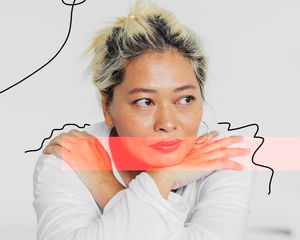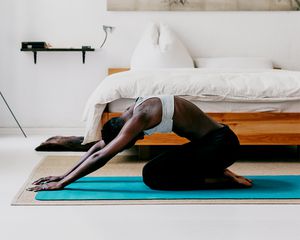:max_bytes(150000):strip_icc()/yoganidra_main-1e105a114d8341c1a78882f5dccaec5f.jpg)
Getty Images/Design by Cristina Cianci
I used to think sleep issues were hereditary. Growing up, when I’d tell my mom I spent the entire night tossing and turning, she’d simply shrug and say no one in our family is a good sleeper. As I got older, and with the help of therapy, I realized that there were things I could do to combat my insomnia. I’ve done it all—sipping calming tea, taking melatonin, and powering down my phone—but for me, the only thing that works every time is prepping for the next day. If I write down everything I need to tackle and choose what I’m wearing ahead of time, I can almost always fall asleep quickly.
But on the days I still can’t fall asleep or had to wake up extremely early without enough hours of shut-eye, I have a new secret: Yoga Nidra. I discovered it on a visit to the Ritz Carlton at Amelia Island, Florida, where they have in-house Yoga Nidra experts, including Liam Gillen, who led my 30-minute class. Yoga Nidra is the best kind of yoga because you’re literally required to do it laying down—as in, yes, not moving at all. Ahead, we asked the experts to break down everything you need to know about the practice before booking your first class.
Meet the Expert
- Liam Gillen is a practitioner and educator of the Amrit Yoga Method of Yoga Nidra. He is a Senior Trainer at the Amrit Yoga Institute where he leads Yoga Nidra trainings, workshops and retreats.
- Valerie Ugrinow is a Master Trainer for YogaSix and the creator of The Golden Mind Project School of Yoga.
- Ariel Mann is a founding instructor at bande, a virtual fitness community.
What Is Yoga Nidra?
Yoga Nidra is the practice of entering the conscious state of mind that falls somewhere between sleeping and being awake. You’re "awake" the entire time you practice, but you’re not exactly alert. The goal is to enter a conscious sleep state and totally relax your brain, therefore releasing any unwanted tension in your body. Gillen claims that, if you do it right, a 30-minute session can be equal to three to four hours of restorative sleep for the body.
“Relaxation is vital to balance and restore your nervous system, yet most people are not getting proper rest day-to-day,” says Valerie Ugrinow, a Master Trainer for YogaSix and the creator of The Golden Mind Project School of Yoga. “Yoga Nidra offers a multidimensional approach to rest, and allows your nervous system to reset.”
Yoga Nidra is the best kind of yoga because you’re literally required to do it laying down—as in, yes, not moving at all. You don’t even need to hold your head up.
The Benefits of Yoga Nidra
Not only does the practice induce instant relaxation, but it can also have lasting effects on your mental state. One study found that Yoga Nidra is an effective therapeutic technique for reducing anxiety and stress levels.Additionally, says Ugrinow, a regular Yoga Nidra practice expands your capacity to handle conflict in stressful situations. “You learn to be present and witness the moment without judging or labeling experiences as good or bad, right or wrong,” she explains. “With greater awareness, you are able to identify and release the patterns in your life that are no longer serving you.” Ariel Mann, a founding instructor at bande, agrees that Yoga Nidra is a great avenue for personal growth and evolution. “It can lead to deep reflections that can help solve and resolve personal and interpersonal challenges and increase one’s sense of purpose in the world,” she explains.
How Yoga Nidra Compares to Meditation
“Classically speaking, meditation is a path to liberation,” says Ugrinow. “It can also be viewed as a way to be present and mindful in the moment, and it strengthens your awareness of what is without judgment or reactivity.” In this way, Yoga Nidra is very similar to meditation, she explains. However, while traditional meditation is usually practiced in the ‘waking’ state, Yoga Nidra “occurs in the space between waking and dreaming, and explores the various dimensions of your being.”
:max_bytes(150000):strip_icc()/GettyImages-1214832465-66da92a7becf42e28c02c3711919ebb6.jpg)
Getty Images
What to Expect During an Yoga Nidra Class
A typical Yoga Nidra class is 30 to 45 minutes long, and you begin by lying down on your back in Savasana (legs extended, arms by your sides with palms facing up). “Some teachers will first guide you through a physical movement or yoga practice to release any extra energy or tension in the body,” says Ugrinow. “This helps prepare you for meditation.”
As if laying down to do yoga wasn’t enough of a luxury, Gillen’s class also provided a blanket and headrest to allow you to get into a truly comfortable state. Gillen said the temperature of the room should never be a distraction, so if it’s drafty, you should make sure to cover up with a blanket.
:max_bytes(150000):strip_icc()/unnamed-49442982e0fe459c8d1f903324c8cfb7-e9859277dd104d879a590adb87e70832.jpg)
Brittany Leitner
According to Ugrinow, the teacher usually then describes the process and what to expect. “Before diving in, the teacher offers an intention (or sankalpa), and then begins to guide you through the experience,” she explains. First, they’ll have you focus your awareness on the physical landscape and sensations of your body. Then, they’ll begin weaving in awareness of the breath and inner landscapes.
Once I was completely comfortable and tucked underneath my blanket, the class began. Gillen instructed us to set an intention. Since I usually have a hard time completely letting go during a class or massage, I set my intention to be as open and as present as possible as the Yoga Nidra class took place. It seemed I was already on the right track, as Gillen mentioned the term “letting go,” multiple times throughout the class. “True relaxation can only occur when you disengage the mind,” he says. “When we disconnect from the thinking (the thinking never truly stops, by the way), you disconnect, create separation from the waves, and tap into this really still, powerful place internally that’s at peace and sustains the body all day long.”
True relaxation can only occur when you disengage the mind.
To start the process of disengaging the mind, Gillen instructed us to take some deep breaths. And then made us aware of each of our limbs, by asking us to lift each heavy section of our body (arms, legs, pelvis, head) and gently drop them back down. Getting a sense of how your body interacts with gravity was part of relaxing your thoughts. Gillen then led the class to bodily touchpoints and told us to focus on relaxing each space. He had us make fists and release them; he had us be aware of our mouth line and relax our muscles; he told us to have our jaw slightly opened in a relaxed position.
In between calling on the class to relax parts of our body, he’d make us aware of our judgment. Repeatedly, he reminded us that we can allow any distraction—either a noise distraction or a thought—to draw us further into our meditation. If we noticed we were getting sidetracked, he simply told us to use that to pull ourselves deeper into the peace we were exploring.
“During the actual practice of Yoga Nidra, there is little to no movement, so it is important to take the time to fully get comfortable before diving in,” Ugrinow explains. “If you find yourself drifting off or struggling to stay awake, you can squeeze a fist now and then to help remain conscious.”
He then led us through a counting breath sequence that went like this: One I am breathing in, one I am breathing out; two I am breathing in, two I am breathing out, and so forth. After Gillen instructed us to return to our regular breathing, he described images to pull us deeper into the trance. He described snow-capped mountains in our view and changed them through various nature scenes. At this point, I was fully relaxed. I felt my mind grow still and the distractions became infrequent. For me, when I hit a peak Yoga Nidra state, my body felt heavy, but still, my thoughts were completely in line with Gillen’s voice, and I woke up feeling like I had just crawled out of a long nap.
“At the completion of the practice, you conclude with revisiting the intention and slowly making your way back up to a seated position,” Ugrinow explains.
How to Practice Yoga Nidra at Home
If you want to try Gillen's class at home, all you have to do is lay down in a comfortable position, and follow along to one of his guided meditation videos. In order to prepare for your at-home practice, Mann suggests making an effort to be as comfortable and relaxed as possible. “Do this by selecting a time and place where noises and other distractions are limited so that your relaxation is not interrupted,” she says. She also recommends wearing comfortable clothes and adding extras like pillows, blankets, and eye masks to ensure that your body feels supported.
:max_bytes(150000):strip_icc()/GettyImages-1308490503-ffdc6ab2f16e4b8c924983aa865c369c.jpg)
Getty Images
Ugrinow agrees that adding an at-home practice is a great way to maintain consistency and reap the full benefits of Yoga Nidra. “There are many great guided recordings that you can listen to from the comfort of your home that will steer you through the various phases of the practice,” she says. However, there is one area of the home she says to avoid when practicing. “I recommend not practicing Yoga Nidra in your bed, because that will likely cause you to fall asleep.”
Instead, Ugrinow suggests spreading out your yoga mat and using a pillow or bolster under your knees to find greater comfort. “Some students also enjoy the weight of a heavy blanket or a bolster across their lower abdomen to help ease an anxious mind,” she adds.
The Final Takeaway
Whether you have five minutes or 30, practicing Yoga Nidra can truly allow you to power down in a way that’s restorative. And while it might require some practice to enter that relaxing state, Ugrinow reminds us that all forms of meditation take time and consistency, and feel different day-to-day. “In the beginning you may fall asleep or notice your mind wandering off, and that’s OK,” she says. “Remember that this is ultimately a practice of being nonjudgmental. So be kind to yourself, keep showing up, and you will start to notice the benefits as the practice gets easier.”




